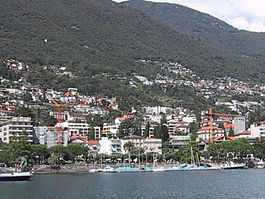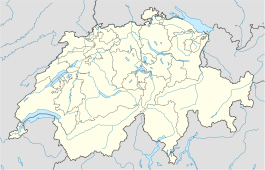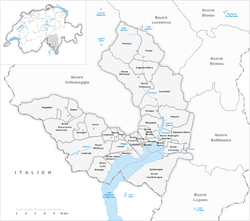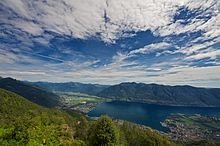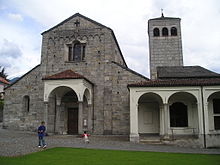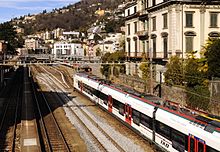- Muralto
-
Muralto Country Switzerland 
Canton Ticino District Locarno 46°10′N 8°48′E / 46.167°N 8.8°ECoordinates: 46°10′N 8°48′E / 46.167°N 8.8°E Population 2,799 (Dec 2009)[1] - Density 4,665 /km2 (12,082 /sq mi) Area 0.60 km2 (0.23 sq mi)[2] Elevation 207 m (679 ft) Postal code 6600 SFOS number 5120 Surrounded by Locarno, Minusio, Orselina, Piazzogna, San Nazzaro Website www.muralto.ch
Profile (Italian), SFSO statisticsMuralto is a municipality in the district of Locarno, in the canton of Ticino in Switzerland.
Contents
History
Roman settlement
In the second half of the 19th Century, the ruins of a Roman settlement were discovered. However, all the items discovered in these early excavations are either lost or they are kept in museums in Locarno, Bern and Zurich. In 1936-37 and again in 1947, detailed excavations were carried out, which discovered a large necropolis. Excavations at various sites then followed in 1977 and 1989. According to archaeological findings, the area was uninhabited until a Roman vicus grew up. The vicus stretched along the lake shore and into the surrounding hills.
On the top terrace, there was a vast burial ground, in which about 300 tombs have been discovered. These tombs contained rich grave goods including; coins, terracotta figurines and glass objects from the 1st-2nd Century AD. Noteworthy is the hot decorated bird cup (20-50 AD). It is believed that there are still a number of undiscovered tombs in burial ground.[3]
Below the necropolis was the business district. Both shops and a workshop from 1st Century have been discovered. In the 3rd Century, this area was renovated into a building complex which consisted of a factory and market hall with spas, blacksmiths, glass melting furnace, granaries and warehouses for quartz and steatite.
On the lowest terrace, there were residential buildings, a provisional army camp and Roman villas from the 1st Century AD. The remains of walls and channels show that the settlement was protected and had a steady water supply. The size of the vicus suggests that there existed, at that time, a deep trade relationship between the Alpine valleys and the Po Valley through Lake Maggiore to the Ticino and then the Po rivers.[3]
Church of S. Vittore
By the Middle Ages, the Church of S. Vittore was the mother church of the parish of Locarno and had authority over all of the Locarno region and until the early 15th Century, the Maggia valley as well. The present church of S. Vittore of Locarno, was built in 1090-1100 and is mentioned for the first time in 1152. It served until 1816 as the collegiate church, after which the Church of S. Antonio in Locarno took over this authority. In the 13th to 15th Centuries there was at least a pastor and eight canons at the church. The earliest statues of the church are from 1487.
By the middle of the 12th Century, it was a three-nave church with a significant series of romanesque frescoes. During the restoration of 1965-84, virtually all of the 19th Century repairs were removed. In the 14th and 15th Centuries gothic style frescoes were added. The bell tower, with a bas-relief of St. Viktor's horse (1460–62) from Visconti Castle in Locarno, was built in 1524-27. It was repaired and expanded in 1932.
In 1745 the mortuary chapel (ossuary) with a small porch was added. In 1857, Giacomo Antonio Pedrazzi and Giovanni Antonio Vanoni painted the church.[4]
Medieval town
The former trading post and vicus were abandoned by the beginning of the 5th Century. However, the area around what is now the church of S. Vittore was settled around the same time. The church was built in the 5th or 6th Century on the ruins of a Roman villa from the 1st Century. In the Middle Ages and early modern period, Muralto and Orselina formed the Vicinanza of Consiglio Mezzano, one of the largest in the Locarno area. The Vicinanza consisted, initially, of the settlement on the mountainside (the Squadra di Sopra, today Orselina) and the settlements on the lakeshore (the Squadra di Sotto and the Squadra Tues Basso, consisting of the settlements Consiglio Mezzano, Muralto and Burbaglio). During the Early Middle Ages, there was a castle in Muralto. In 1190, the Bishop of Como granted it to Beltramo and Gaffo de Muralto to hold as a fief. The Muralto family was eventually granted the title of Capitanei and became part of the Corporation of Nobles in Locarno. The castle was destroyed in 1380, and the few remains that were still exposed in late 19th Century, are probably of fortifications that were built in the 15th Century.[4]
Muralto is first mentioned in 1235.[5]
The Church of San Stefano was first mentioned in 1264. It stood next to the church of S. Vittore until 1905, when it was demolished to make way for a hotel park.
Modern Muralto
In 1803, the municipality of Orselina was created with Muralto as a part of Orselina. In 1881, disagreements between the upper and the lower part of the municipality led to Muralto breaking away to form an independent municipality. In 1903 and 1908, two new the resident communities (Vicinanza) were created in the two municipalities. Until 1816, the church of S. Vittore in Muralto was also the church for the municipality of Orselina. In 1926 Muralto broke away from the parish of Locarno to become an independent parish.[4]
In the Middle Ages and into the modern era, the Vicinanza of Consiglio Mezzano owned property and rights in the Magadino valley to Contone. Along the mountain sides, farming and grazing prevailed, while the settlements on the lake shore made their living from fishing and shipping. In the first half of the 19th Century, Locarno established itself as a regional power center, to the detriment of Orselina. The port of Muralto lost its importance as a result of competition from the newly built port (1825–26) in Locarno. Likewise, the salt refinery, which was on the stream Ramogna, was replaced when a salt storage plant was built in Locarno in 1829. In the second half of the 19th Century, industrial and tourism businesses grew up in the shoreline settlements, due to the construction of the railroad in 1874. The mountain settlements, however, remained dependent on traditional farming. Muralto experienced a real industrial expansion and became a leading industrial center in the area. In 1874 Birreria Nazionale built a factory in town. Between 1886-95 Bacilieri spinning was active in Muralto. Between the end of World War I and the mid-20th Century a number of watch manufactures also set up factories in town. The first modern tourist institutions in the region originated in Muralto. Between 1874-76, the Grand Hôtel was built, followed in 1886 by the Hotel Reber, both of which were closed in 2006. Then, in 1894, the Park Hotel was built. It was replaced in 1986 by a nursing home.[4]
In 1893, Muralto was the first municipality in the region to have public, electric lighting. In 1902 the Esperia cinema opened. The strong population growth between 1888-1910 is due an influx of German-speaking Swiss. In 1891, therefore, a Swiss-German school (open until 1994) and in 1901 a Swiss Reformed church were built. In 1925 the Reformed parish became independent and had their own pastor.[4]
Starting in the middle of the 20th Century, Muralto developed into a tourist destination and residential community with a multi-purpose conference center of regional importance. The development between 1950–70, replaced the late 19th Century villas and parks, with modern buildings. In 2000, a fifth of the population was German and almost three quarters of all workers came from abroad. In 2005, approximately 95% of jobs in the municipality were in the services sector.[4]
Geography
Muralto has an area, as of 1997[update], of 0.6 square kilometers (0.23 sq mi). Of this area, 0.43 km2 (0.17 sq mi) or 71.7% is used for agricultural purposes, while 0.02 km2 (0.0077 sq mi) or 3.3% is forested. Of the rest of the land, 0.56 km2 (0.22 sq mi) or 93.3% is settled (buildings or roads) and 0.01 km2 (2.5 acres) or 1.7% is unproductive land.
Of the built up area, housing and buildings made up 68.3% and transportation infrastructure made up 18.3%. while parks, green belts and sports fields made up 6.7%. Out of the forested land, 1.7% of the total land area is heavily forested and 1.7% is covered with orchards or small clusters of trees. Of the agricultural land, 1.7% is used for growing crops, while 1.7% is used for orchards or vine crops and 68.3% is used for alpine pastures.[6]
The municipality is located in the Locarno district, in the agglomeration of Locarno. It lies along Lake Maggiore and is bordered by the Ramogna and Rabissale streams. It was created in 1881, when it separated from Orselina.[7]
Demographics
Muralto has a population (as of December 2009[update]) of 2,799.[1] As of 2008[update], 26.9% of the population are resident foreign nationals.[8] Over the last 10 years (1997–2007) the population has changed at a rate of -1.1%.
Most of the population (as of 2000[update]) speaks Italian (68.4%), with German being second most common (19.9%) and Macedonian being third (2.8%).[9] Of the Swiss national languages (as of 2000[update]), 533 speak German, 55 people speak French, 1,830 people speak Italian, and 6 people speak Romansh. The remainder (252 people) speak another language.[10]
As of 2008[update], the gender distribution of the population was 45.8% male and 54.2% female. The population was made up of 903 Swiss men (32.3% of the population), and 378 (13.5%) non-Swiss men. There were 1,171 Swiss women (41.8%), and 347 (12.4%) non-Swiss women.[11]
In 2008[update] there were 12 live births to Swiss citizens and 8 births to non-Swiss citizens, and in same time span there were 36 deaths of Swiss citizens and 10 non-Swiss citizen deaths. Ignoring immigration and emigration, the population of Swiss citizens decreased by 24 while the foreign population decreased by 2. There were 2 Swiss men and 4 Swiss women who immigrated back to Switzerland. At the same time, there were 24 non-Swiss men and 20 non-Swiss women who immigrated from another country to Switzerland. The total Swiss population change in 2008 (from all sources, including moves across municipal borders) was a decrease of 4 and the non-Swiss population change was an increase of 25 people. This represents a population growth rate of 0.7%.[8]
The age distribution, as of 2009[update], in Muralto is; 177 children or 6.3% of the population are between 0 and 9 years old and 185 teenagers or 6.6% are between 10 and 19. Of the adult population, 289 people or 10.3% of the population are between 20 and 29 years old. 332 people or 11.9% are between 30 and 39, 395 people or 14.1% are between 40 and 49, and 375 people or 13.4% are between 50 and 59. The senior population distribution is 406 people or 14.5% of the population are between 60 and 69 years old, 312 people or 11.1% are between 70 and 79, there are 328 people or 11.7% who are over 80.[11]
As of 2000[update] the average number of residents per living room was 0.55 which is about equal to the cantonal average of 0.6 per room. In this case, a room is defined as space of a housing unit of at least 4 m2 (43 sq ft) as normal bedrooms, dining rooms, living rooms, kitchens and habitable cellars and attics.[12] About 21.3% of the total households were owner occupied, or in other words did not pay rent (though they may have a mortgage or a rent-to-own agreement).[13]
As of 2000[update], there were 1,448 private households in the municipality, and an average of 1.8 persons per household.[9] In 2000[update] there were 92 single family homes (or 22.9% of the total) out of a total of 402 inhabited buildings. There were 49 two family buildings (12.2%) and 167 multi-family buildings (41.5%). There were also 94 buildings in the municipality that were multipurpose buildings (used for both housing and commercial or another purpose).[14]
The vacancy rate for the municipality, in 2008[update], was 0.37%. In 2000[update] there were 2,106 apartments in the municipality. The most common apartment size was the 3 room apartment of which there were 659. There were 247 single room apartments and 221 apartments with five or more rooms.[15] Of these apartments, a total of 1,435 apartments (68.1% of the total) were permanently occupied, while 612 apartments (29.1%) were seasonally occupied and 59 apartments (2.8%) were empty.[15] As of 2007[update], the construction rate of new housing units was 4.3 new units per 1000 residents.[9]
The historical population is given in the following table:[5]
year population 1850 782 1888 1,019 1900 1,502 1910 1,950 1950 2,673 1970 3,090 2000 2,676 Heritage sites of national significance
The Collegiata Di S. Vittore, the Grand Hotel and the Vicus at via della Collegiata/via del Municipio are listed as Swiss heritage site of national significance.[16]
Transportation
The Locarno railway station is located within the Muralto municipality.
Politics
In the 2007 federal election the most popular party was the CVP which received 30.17% of the vote. The next three most popular parties were the FDP (26.92%), the SP (14.75%) and the SVP (11.98%). In the federal election, a total of 834 votes were cast, and the voter turnout was 45.0%.[17]
In the 2007[update] Gran Consiglio election, there were a total of 1,897 registered voters in Muralto, of which 998 or 52.6% voted. 22 blank ballots and 4 null ballots were cast, leaving 972 valid ballots in the election. The most popular party was the PPD+GenGiova which received 291 or 29.9% of the vote. The next three most popular parties were; the PLRT (with 183 or 18.8%), the SSI (with 176 or 18.1%) and the PS (with 119 or 12.2%).[18]
In the 2007[update] Consiglio di Stato election, 15 blank ballots and 7 null ballots were cast, leaving 976 valid ballots in the election. The most popular party was the PPD which received 280 or 28.7% of the vote. The next three most popular parties were; the LEGA (with 165 or 16.9%), the PLRT (with 160 or 16.4%) and the SSI (with 159 or 16.3%).[18]
Economy
As of 2007[update], Muralto had an unemployment rate of 6.52%. As of 2005[update], there were 2 people employed in the primary economic sector and about 1 business involved in this sector. 53 people were employed in the secondary sector and there were 15 businesses in this sector. 1,199 people were employed in the tertiary sector, with 215 businesses in this sector.[9] There were 1,123 residents of the municipality who were employed in some capacity, of which females made up 43.4% of the workforce.
In 2000[update], there were 1,162 workers who commuted into the municipality and 738 workers who commuted away. The municipality is a net importer of workers, with about 1.6 workers entering the municipality for every one leaving. About 5.3% of the workforce coming into Muralto are coming from outside Switzerland.[19] Of the working population, 12.5% used public transportation to get to work, and 42.2% used a private car.[9]
As of 2009[update], there were 18 hotels in Muralto with a total of 463 rooms and 824 beds.[20]
Religion
From the 2000 census[update], 1,713 or 64.0% were Roman Catholic, while 365 or 13.6% belonged to the Swiss Reformed Church. There are 464 individuals (or about 17.34% of the population) who belong to another church (not listed on the census), and 134 individuals (or about 5.01% of the population) did not answer the question.[10]
Education
In Muralto about 61.1% of the population (between age 25-64) have completed either non-mandatory upper secondary education or additional higher education (either university or a Fachhochschule).[9]
In Muralto there were a total of 314 students (as of 2009[update]). The Ticino education system provides up to three years of non-mandatory kindergarten and in Muralto there were 39 children in kindergarten. The primary school program lasts for five years and includes both a standard school and a special school. In the village, 104 students attended the standard primary schools and 5 students attended the special school. In the lower secondary school system, students either attend a two year middle school followed by a two year pre-apprenticeship or they attend a four year program to prepare for higher education. There were 79 students in the two year middle school and 2 in their pre-apprenticeship, while 40 students were in the four year advanced program.
The upper secondary school includes several options, but at the end of the upper secondary program, a student will be prepared to enter a trade or to continue on to a university or college. In Ticino, vocational students may either attend school while working on their internship or apprenticeship (which takes three or four years) or may attend school followed by an internship or apprenticeship (which takes one year as a full-time student or one and a half to two years as a part-time student).[21] There were 15 vocational students who were attending school full-time and 25 who attend part-time.
The professional program lasts three years and prepares a student for a job in engineering, nursing, computer science, business, tourism and similar fields. There were 5 students in the professional program.[22]
As of 2000[update], there were 5 students in Muralto who came from another municipality, while 219 residents attended schools outside the municipality.[19]
References
- ^ a b Swiss Federal Statistical Office, MS Excel document – Bilanz der ständigen Wohnbevölkerung nach Kantonen, Bezirken und Gemeinden (German) accessed 25 August 2010
- ^ Arealstatistik Standard - Gemeindedaten nach 4 Hauptbereichen
- ^ a b Muralto - Roman era in German, French and Italian in the online Historical Dictionary of Switzerland.
- ^ a b c d e f Muralto - Middle Ages to the 21st Century in German, French and Italian in the online Historical Dictionary of Switzerland.
- ^ a b Muralto in German, French and Italian in the online Historical Dictionary of Switzerland.
- ^ Altitudine, superficie, secondo il genere di utilizzazione, rilevazione 1992/1997, e densità della popolazione, nel 2000 (Italian) accessed 25 October 2010
- ^ Amtliches Gemeindeverzeichnis der Schweiz published by the Swiss Federal Statistical Office (German) accessed 14 January 2010
- ^ a b Swiss Federal Statistical Office - Superweb database - Gemeinde Statistics 1981-2008 (German) accessed 19 June 2010
- ^ a b c d e f Swiss Federal Statistical Office accessed 09-December-2010
- ^ a b Popolazione residente, secondo la lingua principale e la religione, nel 2000 (Italian) accessed 23 November 2010
- ^ a b 01.02.03 Popolazione residente permanente (Italian) accessed 23 November 2010
- ^ Eurostat. "Housing (SA1)" (pdf). Urban Audit Glossary. 2007. p. 18. http://www.bfs.admin.ch/bfs/portal/en/index/international/22/lexi.Document.116365.pdf. Retrieved 12 February 2010.
- ^ Urban Audit Glossary pg 17
- ^ 09.02.01 Edifici (Italian) accessed 23 November 2010
- ^ a b 09.02.02 Abitazioni (Italian) accessed 23 November 2010
- ^ "Kantonsliste A-Objekte:Ticino" (in German). KGS Inventar. Federal Office of Civil Protection. 2009. http://www.bevoelkerungsschutz.admin.ch/internet/bs/de/home/themen/kgs/kgs_inventar/a-objekte.parsys.000117.DownloadFile.tmp/ti.pdf. Retrieved 12 July 2010.
- ^ Swiss Federal Statistical Office, Nationalratswahlen 2007: Stärke der Parteien und Wahlbeteiligung, nach Gemeinden/Bezirk/Canton (German) accessed 28 May 2010
- ^ a b Elezioni cantonali: Gran Consiglio, Consiglio di Stato (Italian) accessed 23 November 2010
- ^ a b Swiss Federal Statistical Office - Statweb (German) accessed 24 June 2010
- ^ Settori alberghiero e paralberghiero (Italian) accessed 23 November 2010
- ^ EDK/CDIP/IDES (2010). KANTONALE SCHULSTRUKTUREN IN DER SCHWEIZ UND IM FÜRSTENTUM LIECHTENSTEIN / STRUCTURES SCOLAIRES CANTONALES EN SUISSE ET DANS LA PRINCIPAUTÉ DU LIECHTENSTEIN (Report). http://edudoc.ch/record/35128/files/Schulsystem_alle.pdf. Retrieved 24 June 2010.
- ^ Allievi e studenti, secondo il genere di scuola, anno scolastico 2009/2010 (Italian) accessed 23 November 2010
External links
- Official website (Italian)
Lake Maggiore (Lago Maggiore, Verbano) Settlements Angera · Arona · Ascona · Baveno · Belgirate · Besozzo · Brebbia · Brezzo di Bedero · Brissago · Cannero Riviera · Cannobio · Castelletto sopra Ticino · Castelveccana · Caviano · Dormelletto · Germignaga · Gerra (Gambarogno) · Ghiffa · Ispra · Laveno-Mombello · Leggiuno · Lesa · Locarno · Luino · Maccagno · Magadino · Meina · Minusio · Monvalle · Muralto · Oggebbio · Piazzogna · Pino sulla Sponda del Lago Maggiore · Porto Valtravaglia · Ranco · Ronco sopra Ascona · San Nazzaro · Sant'Abbondio · Sesto Calende · Stresa · Tenero-Contra · Tronzano Lago Maggiore · Verbania · Vira

Islands Isole Borromee (Isola Bella · Isola Madre · Isola dei Pescatori · Isolino di San Giovanni) · Isole di Brissago (Isola San Pancrazio · Isola Sant’Apollinare) · Castelli di Cannero · Isolino PartegoraRivers Boesio · Cannobino · Giona · Maggia · Margorabbia · San Bernardino · Stronetta · Ticino · Toce · Tresa · VerzascaLandmarks Films People Ascona | Brione | Brione sopra Minusio | Brissago | Cavigliano | Centovalli | Corippo | Cugnasco-Gerra | Frasco | Gambarogno | Gordola | Gresso | Isorno | Lavertezzo | Locarno | Losone | Mergoscia | Minusio | Mosogno | Muralto | Onsernone | Orselina | Ronco sopra Ascona | Sonogno | Tegna | Tenero-Contra | Vergeletto | Verscio | Vogorno
Ticino | Districts of Canton Ticino | Municipalities of the canton of Ticino
 Categories:
Categories:- Municipalities of Ticino
- Municipalities of Switzerland
- Cultural property of national significance in the canton of Ticino
Wikimedia Foundation. 2010.

